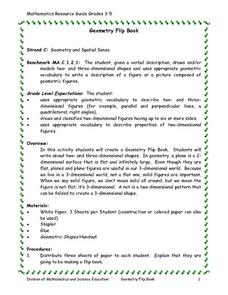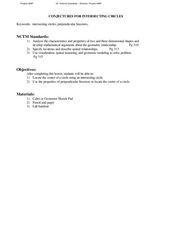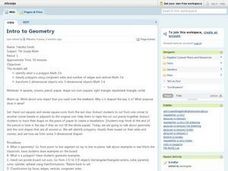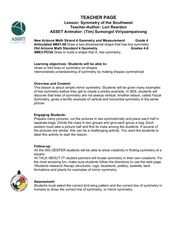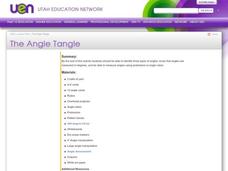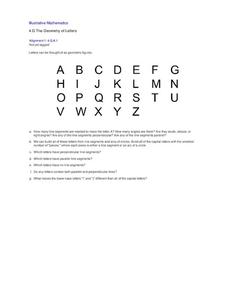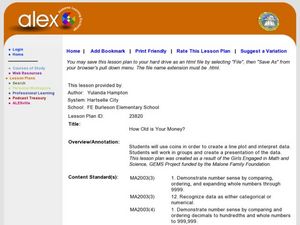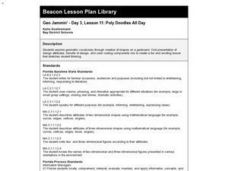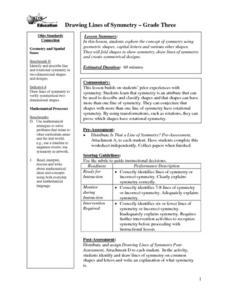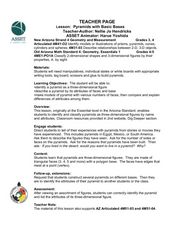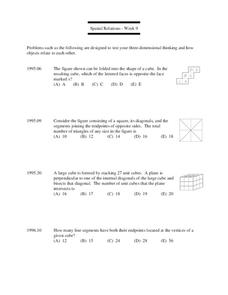Curated OER
Identifying Faces, Edges, and Vertices
Fourth graders examine faces, edges, and vertices. In this geometry lesson, 4th graders participate in classroom activities that require them to compare geometric shapes, figures, and models.
Curated OER
Geometry Flip Book
Young scholars investigate the concepts of geometry that can be grouped into a flip book that can be used for teaching and review purposes. They define the differences between two and three dimensional figures. Also polygons are reviewed...
Curated OER
Conjectures of Intersecting Circles
Young scholars make conjectures of intersecting circles. In this geometry lesson, students observe circles and their position in space. They investigate and observe two and three dimensional objects.
Curated OER
Exploring Geometric Mean
Student identify the solution using geometric mean. In this geometry lesson, students create right triangles where the altitude of the triangle is the side containing the right angle. They modify shapes using Cabri software and observe...
Curated OER
Geometry Shapes Playground Safety
Young scholars create a new playground design to present to elementary students during Playground safety week. They review basic geometry to use in observing and recording the equipment on a local playground. They research playground...
Curated OER
Conjectures For Intersecting Circles
Students identify properties of circles. For this geometry lesson, students identify the center of two intersecting circles.They use Cabri software to create circles and move it around to make observation.
Curated OER
Intro to Geometry
Seventh graders identify a polygon and classify them using congruent sides and number of edges and vertices. Students transform two dimensional objects into three dimensional objects.
Curated OER
Standard Treehouse Lesson Plan
Seventh graders investigate the concepts related to the geometry of treehouses that focuses on angles that are similar and congruent. They conduct class discussion in terms of looking at three dimensional shapes that are represented in...
Curated OER
Symmetry of the Southwest
Fourth graders examine mirror symmetry. In this symmetry lesson, 4th graders discover that symmetry is not always vertical or horizontal. Students cut and fold shapes along lines of symmetry.
Curated OER
Geometric Figures
Students identify two and three dimensional shapes and use appropriate geometric vocabulary to write a description of the figure by taking pictures of geometric figures in their own environment.
Curated OER
Angles
Fourth and fifth graders investigate angles and name them according to the criteria for obtuse, acute, and right angles. They examine a human-made yarn pattern on the floor of their classroom and identify angles, vertices, and types of...
Illustrative Mathematics
The Geometry of Letters
Use the alphabet as a tool for teaching your class about geometric figures. Break apart capital letters into line segments and arcs. Classify angles as right, acute, or obtuse. Identify parallel and perpendicular lines. An excellent...
Arizona State University
Tricorn Triangles
Help your learners examine triangles. Pupils explore the different sizes and measurements of triangles. They discover triangles can be isosceles or scalene, and examine the attributes of triangles. Here is the website where you can...
Alabama Learning Exchange
How Old is Your Money?
Elementary learners explore coin mint dates. First, they listen to the book Alexander Who Used to be Rich Last Sunday by Judith Viorst. They then sort a collection of coins according to their mint date and put them in order from oldest...
Curated OER
Comparing Measurements
Students explore measurements by completing worksheets in class. For this geometry lesson, students identify the basic measurement units in both the English and metric systems. Students analyze 2 and 3 dimensional objects and identify...
Curated OER
Geo Jammin' - Day 3, Lesson 11: Poly Doodles All Day
Pupils explore geometric vocabulary through creation of shapes on a geoboard. They present design attributes, transfer of design, and color-coding components mix to create a fun and exciting instructional activity that stretches student...
Curated OER
Tiling the Plane
Fifth graders use pattern blocks and triagular grid paper to reivew shape names, be introduced to the concept of a tiling of the plane, and determine which pattern blocks tile the plane. They are asked if they comprehend what a...
Curated OER
Drawing Lines of Symmetry
Third graders explore the concept of symmetry using geometric shapes, capital letters and various other shapes. They fold shapes to show symmetry, draw lines of symmetry and create symmetrical designs.
Curated OER
Pyramids with Basic Bases
Students explore pyramids. In this math lesson, students discuss where they have seen examples of pyramids. Students classify pyramids as three-dimensional figures and identify their attributes.
Curated OER
Exploring the Properties of Rectangular Prisms.
Learners define properties of rectangular prisms. In this geometry lesson, students identify the relationship between two and three dimensional objects. They use Cabri technology to graph their figures.
Curated OER
Exploring Chords: Products of Chord Segments
Students identify the properties of chords. In this geometry lesson, students multiply chord segments to find the solution to their problem. They construct two chords that cross on a circles.
Noyce Foundation
Parallelogram
Parallelograms are pairs of triangles all the way around. Pupils measure to determine the area and perimeter of a parallelogram. They then find the area of the tirangles formed by drawing a diagonal of the parallelogram and compare their...
Curated OER
Spatial Relations - Week 9
In this spatial relations worksheet, students solve three-dimensional problems. They find the total number of triangles in a given figure, the number of line segments that endpoints and use integer points to solve two problems. This...
Curated OER
Animal Tracks
Students are introduced to the topic of area. In groups, they share various techniques to help them identify different shapes and work together to calculate the area. They use this same knowledge to determine the area of animal tracks...

